Food security has been a significant concern for Bihar even before the outbreak of COVID-19. According to the 2020-21, Composite SDG Index by NITI Aayog, Bihar ranks lowest with score 52as against the highest score of 75 for Kerala among the states in India. Bihar stood the second last with score 31 and is only above Jharkhand (19) in terms of SDG 2. Covid-19 is likely to aggravate the food and nutrition status of the already vulnerable population and undermine the efforts put to achieve SDG 2 of Zero Hunger. Telephonic survey was conducted in seven districts of Bihar with support from International Growth Center (IGC) to collect the information on consumption of food groups before the pandemic and the current period based on the recall method (12 months, 7 days, and 24 hours),allow us to analyze the food security challenges faced by the vulnerable households in rural Bihar since the pandemic. The following findings are emerged from the survey:
- Drastic Reduction in Number of Days of Consumption of Food Groups
- Except for food groups’ cereals, oils and spices, there has been a drastic reduction in household consumption of other food items.
- Consumption of meat reduced by 83 percent; fruits and eggs by 75 percent and pulses by 60 percent since the pandemic. The likely reasons for this reduction are fear of corona, price hike and closure of markets.
- Consumption of fish declined by 38% due to fish being expensive and partially due to fear of corona.
- Even consumption of roots and tubers and green/yellow leafy vegetables dwindled by 32% and 18% respectively, likely due to a hike in the price of products followed by non-availability of the items.
Fig 1A: Consumption of Food Groups Figure 1B: Supply-Side Constraint in Accessing Average no of Days/ Month Food
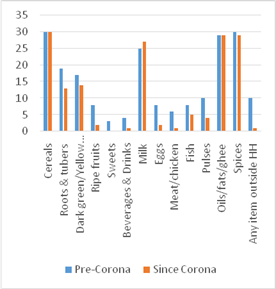
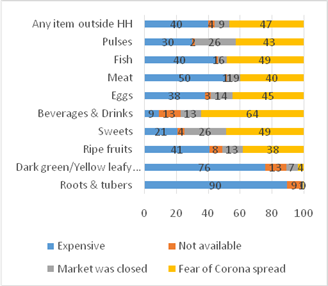
- Unevenly Affected the Food and the Nutrition Security of the Marginalized Households and also the Children
- In terms of households dietary diversity i.e number of food groups consumed in a day is much lower among the casual worker households and migrant worker households than salaried households. The percentage of households having consumed more than 6 food groups is 12 percentage point lesser among casual wage households and 10 percentage point lesser among the migrant households compared to the salaried households.
- Children have also been severely affected in casual and migrant households. The vast majority of the children consumed only cereals and vegetables mostly potatoes in a week in the majority of the casual and migrant households since pandemic. Children consumed pulses, fruits, and non-vegetarian items once in seven days since the pandemic. This will aggravate the malnutrition status of the children in the long run.
Figure 2A: Households Dietary Diversity Figure 2B: Food Frequency of a Child
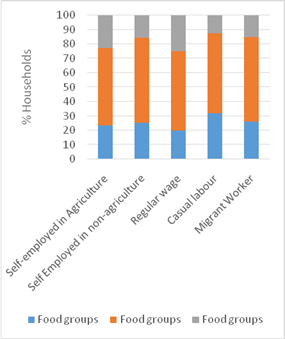
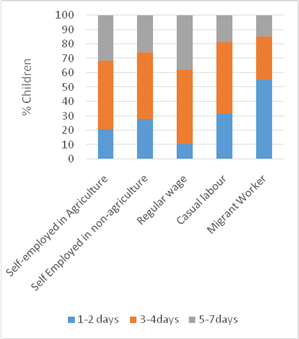
- Shortage of Food is the Sources of Worry Since Pandemic
- Approximately 3 in 5 households were worried about not having enough food to eat as well as worried that they would not be able to eat a healthy and diverse variety of food item since the COVID-19 outbreak.
- One-fourth of the households depended only on a limited type of food items. More than two-fifth of the households ate less amount of food.
- Around 12 percent of the households skipped a meal and 11 percent of the households also felt hungry.
- Some of the households (5 percent) also reported that they spent the entire day without eating
Figure 3: Self Assessed Household Food Insecurity
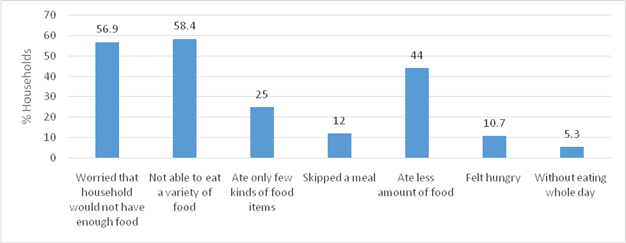
Effectiveness of the Government programme
One of the relief measures announced included the free provision of an additional ration of 5 kg of wheat or rice per person and one kg of pulses per household per month to all ration card holders under the Public Distribution System (PDS). This was over and above their regular entitlement under the National Food Security Act. Around 20 percent of the households did not have a ration card and hence, were automatically excluded as they did not meet the eligibility criteria to benefit from the relief measure. PDS plays a major role in terms of maintaining household food security at the time of a pandemic. According to the respondents compared to the normal period PDS ration supports the households in a much better way to mitigate the food shortage during the pandemic. Almost one fourth of the respondents feel PDS ration support more than 3 weeks of requirements as against only 1 percent opined the same in the normal period.
Figure4A: Support from PDS Figure4B: THR supports for child nutrition
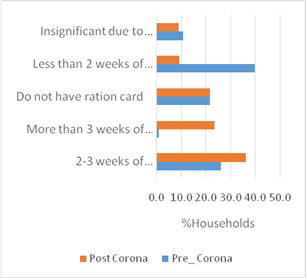
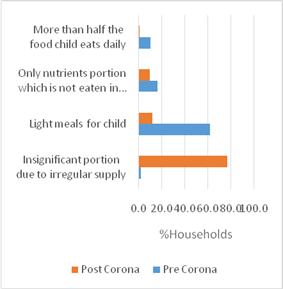
On the contrary role of ICDS in providing child nutritional supplement got disturbed due to the disruption in the functioning of the AWC during the pandemic. Almost half of the eligible households did not receive the supplementary food or Take Home Ration. Among the households who have received THR, one in four beneficiaries received them rarely, and approximately two out of ten beneficiaries received them sometimes. As expected 8 out of 10 eligible beneficiary quoted that supplementary nutrition supports an insignificant portion due to the irregular supply of THR.
Maintaining a healthy nutritious diet is essential to support a strong immune system to fight the pandemic. However rural Bihar is facing challenging tradeoff between COVID-19 and food availability, access and livelihood. Although government of India has announced several relief package large proportion of the households received the amount much lower than the announced amount. Larger proportion of the households also excluded from the benefit although they were eligible to receive it. Sustainable intervention by the government is needed to smooth the availability and accessibility of the food to maintain the proper dietary diversity of the households during the pandemic. Strengthening Social protection scheme is a key to improve the access to food, nutrition, essential services particularly for the marginalized and vulnerable households during any economic shocks. The findings of this study suggest that there is a need for cash transfer to the beneficiaries' accounts in case of ICDS or Mid-day meal scheme where beneficiaries could not receive the Take Home Ration due to disruption of the AWC and the closure of the school. Also, there is an immediate requirement to increase the manpower to the AWC for smooth functioning of their routine work otherwise that have long term implication on the child and pregnant and lactating mothers’ nutrition.
(The views and opinions expressed in this article are those of the authors)
Authors:

Dr. Swati Dutta,
Fellow, Institute for Human Development, New Delhi
|

Dr. Sunil Kumar Mishra,
Fellow, Institute for Human Development, New Delhi
|

Dr. Ashwani Kumar, Programme Officer, Institute for Human Development, Ranchi
|
